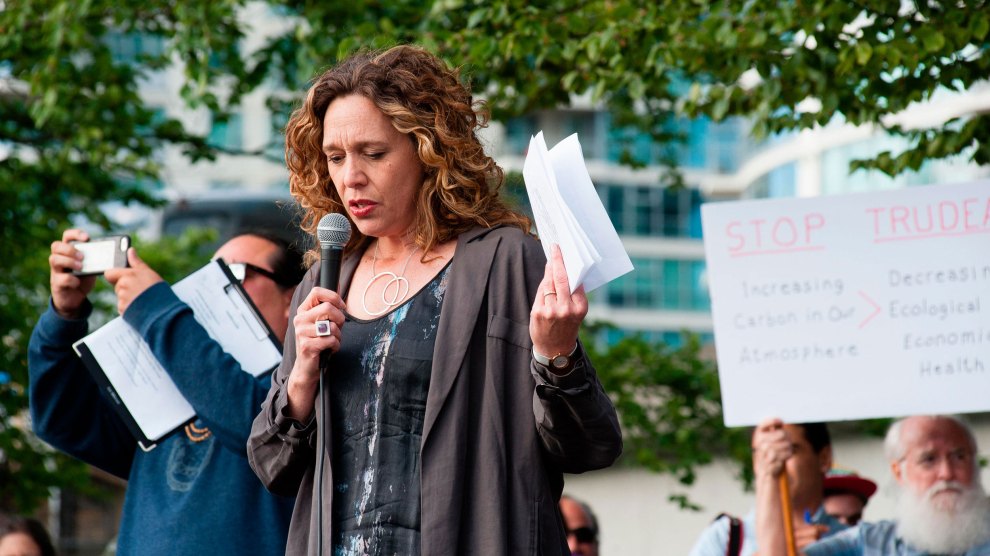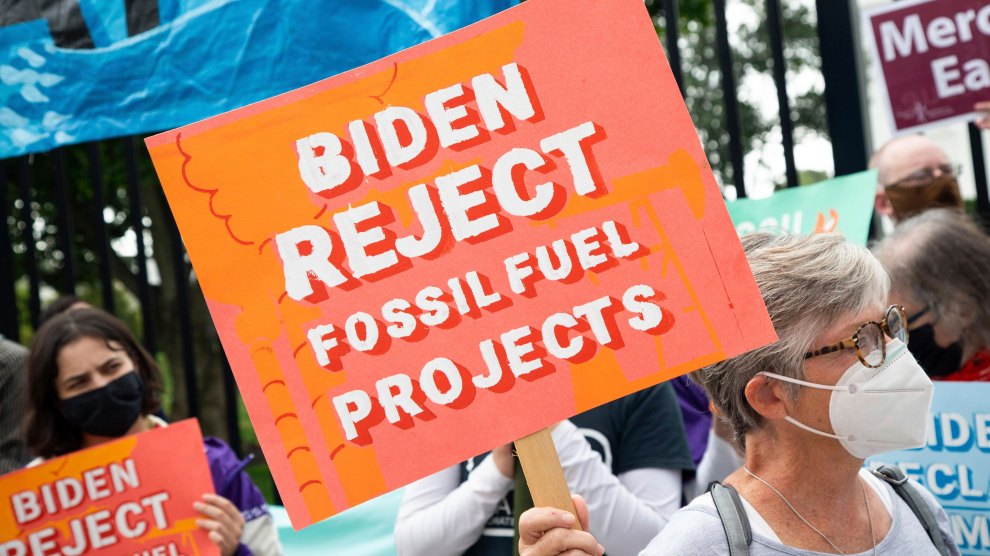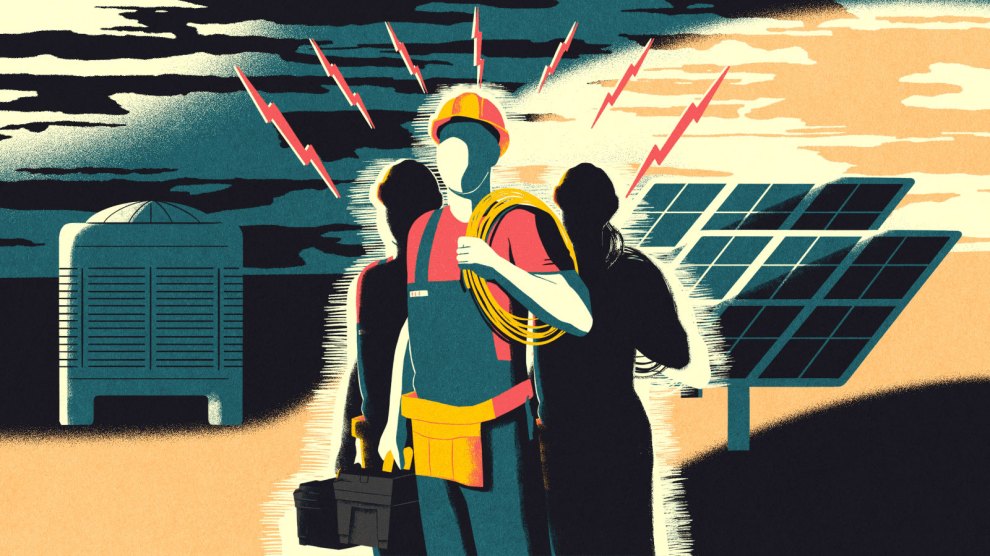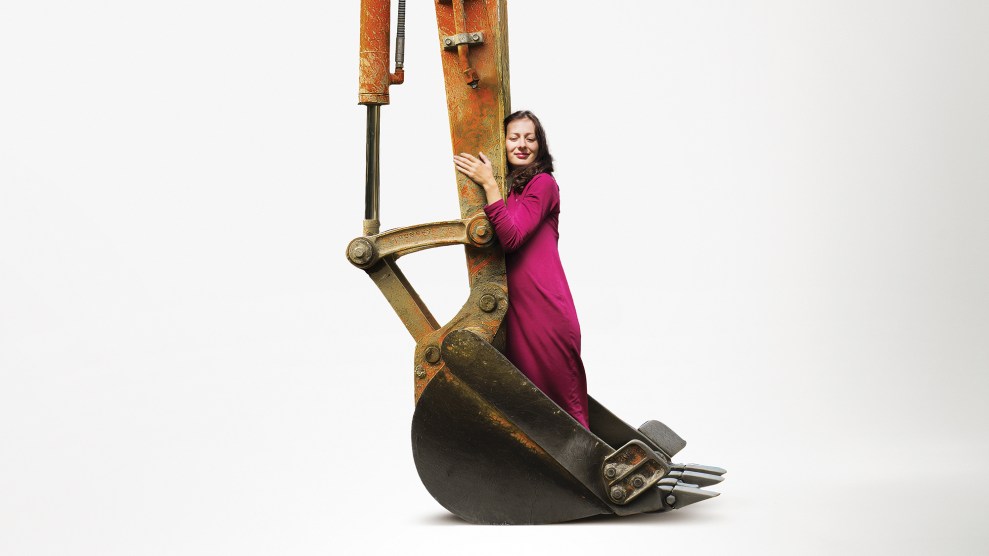
Tzeporah Berman, chair of the Fossil Fuel Non-Proliferation Treaty at a pipeline protest in British Columbia.Patrick Gillin/Alamy/Hakai Magazine
The United States is on the brink of its most consequential transformation since the New Deal. Read more about what it takes to decarbonize the economy, and what stands in the way, here. This story was originally published by Hakai Magazine and is reproduced here as part of our Climate Desk collaboration.
Imagination is a powerful thing.
Mary Shelley predicted organ transplantation in her novel Frankenstein, published in 1818. George Orwell predicted the surveillance state back in 1949 when he published 1984. Star Trek–creator Gene Roddenberry and his team of writers predicted cellphones, GPS, and Zoom in the 1960s. In the 1980s, Star Trek: The Next Generation writers predicted touchscreen monitors and talking directly to your computer.
All fiction writers, they based their ideas on what they knew about technology and society at the time, making a leap from the potential to the possible. Sometimes the writers grappled with the negative societal consequences of change—most notably Shelley and Orwell. Others, such as Roddenberry and his crew of writers, wove technological and societal change into stories with the fundamental premise that people are good and the world will ultimately be a better place.
We’re darn good at imagining each of the scenarios proposed by Shelley, Orwell, and Roddenberry: conquering space, the cult of authoritarianism, and our fallibility when it comes to scientific discovery. I question how good we are at imagining action on climate change. And maybe that feeds into our collective paralysis to move on from fossil fuels: we can’t imagine life without them.
In climate change fiction, writers often imagine the worst future ever, over and over and over. Octavia Butler’s novel Parable of the Sower, set in 2024, is post-apocalyptic with characters navigating climate calamity, corporate greed, and a collapsed society. Butler skips over any actions to subvert climate change—it’s a fait accompli—but her characters act, they have agency, and by the end of the book they are solving problems and imagining a better world. The novel hit the bestseller list in 2020, long after its 1993 publication.
What if we imagined a more boring world, one that has successfully transitioned off fossil fuels? Yes, the four horsemen of the apocalypse—war, pestilence, drought, famine—make appearances in the world today, unfairly targeting marginalized communities, but we’re not yet at the cliff’s edge, the precipice we’ll reach sometime in the mid-2030s if we continue to turn away from the possible.
Fiction reels in readers through tension, plot, protagonists, and antagonists, so a dystopic future is probably more attractive to a novelist. Nonfiction writers trade in facts; we can’t make up stuff, but we can imagine a future where dystopia is not a fait accompli.
In 1993, for example, on the west coast of Vancouver Island, British Columbia, a community activist handed a megaphone to Tzeporah Berman and asked her to explain why cutting the old-growth trees in an intact temperate rainforest was a bad idea. Berman climbed up onto a van and started talking—and so began her journey in communicating to her fellow citizens, and the media, the possibility of a future with big trees.
Berman helped galvanize the protestors that day 30 years ago when she questioned the ethics of logging old-growth trees in Clayoquot Sound. Citizens swarmed to the region, blocking logging roads leading to the big trees, and the protest became a cause célèbre, culminating in one of the largest instances of civil disobedience in Canadian history and the arrest of over 800 people, including Berman, who the BC premier at the time called an enemy of the state. Today, Clayoquot Sound is a UNESCO Biosphere Reserve. A group of people collectively imagined a different future, the media broadcast their story around the world, and the future changed.
Since accepting that megaphone, Berman has kept trees standing through creative means. Never underestimate what women in underwear and wielding chainsaws can do for the boreal forest: a full-page ad in the New York Times with a photograph of a lingerie-clad model holding a saw, along with underwear-clad students holding paper saws demonstrating at Victoria’s Secret outlets, convinced the company to stop printing their catalog on paper from old-growth trees. But by 2007, it was obvious that saving trees was—in Berman’s words—like painting the Titanic after it hit an iceberg. Avoiding the iceberg that can sink the planet—i.e. 2 degrees C of global warming—is a better strategy in need of a bold, imaginative move.
Our imaginations are maybe made too small by our attachment to fossil fuels. Our attachment is so profound that Berman, when she searched the Paris Agreement—an international accord to cut carbon emissions and hold the planet to 1.5C of warming—for mentions of oil, gas, and coal, found nothing.
“And that’s when I started contacting academics around the world to try and understand: am I literally missing something, like what mechanisms exist within this agreement to constrain the production of fossil fuel? And I was told, there aren’t any,” Berman says via Zoom from her home in Vancouver, British Columbia. “We’re on track to produce 110 percent more oil, gas, and coal between now and 2030, more than the world could ever burn and stay below 1.5 degrees.” Why produce a resource we absolutely cannot burn if we want to avoid catastrophic warming? It’s like telling alcoholics they need to stop drinking or they’ll die, then handing them bottles of vodka.
Why not focus on supply—on oil, gas, and coal?
An explicit call from Pacific Islands for a ban on coal as well as two decades’ worth of work on climate justice fed into the idea of an international fossil fuel treaty. Ideas, a writer friend once told me, are often polyamorous, attaching themselves to a variety of people at the same time. In that vein, academics unveiled the concept of a fossil fuel nonproliferation treaty in an article for The Guardian in 2018.
Then, in 2019, the Climate Breakthrough Project, which funds bold ideas, awarded Berman $2 million. With the award, she launched the global campaign for the treaty, modeled after a number of global treaties, including the Treaty on the Non-Proliferation of Nuclear Weapons (a success in context—nonnuclear countries agreed to not pursue nuclear arms in 1968, keeping nuclear weapons states to a minimum). The nuclear treaty spelled out three pillars of action, a straightforward and elegant concept echoed in the Fossil Fuel Non-Proliferation Treaty: ending the exploration for and production of oil, gas, and coal; phasing out existing stockpiles and production in line with the Paris Agreement’s 1.5C goal; and ensuring a just transition to a post–fossil fuel world.
The boldest and most imaginative ideas are often simple and possible and world-changing. For example, by 2009 every country in the world ratified the 1987 Montreal Protocol to protect the ozone layer, which blocks the sun’s most harmful rays. Soon after, the world stopped producing and consuming chlorofluorocarbons, the chemicals that deplete the ozone layer. (Of course, some simple and possible and world-changing ideas are bad—the synthesizing of leaded fuel in 1921, for instance.)
I asked Berman how she felt when she realized constraining production could achieve pro-planet results. “At first, I would say that it felt like a relief, like finding a puzzle piece when you needed the last one, and it fits,” she says. “This makes so much sense to me now. And it was fairly quickly followed by terror, like the moment when you realize that you have faith in a global system and decision-makers, and they’re just human. They’re part of a big groupthink that is missing huge pieces of the puzzle.”

Protesters outside the White House in October 2021.
Karla Cote/SOPA Images/AP
Compared with emissions, production is easier to grasp, perhaps because we can see black coal and feel coal dust, we can see and feel an oil slick, and we can smell and see the shimmer of gas. Writing mentor Priscilla Long advises writers—nonfiction and fiction—to use concrete nouns, the sensory kind, words perceived through the eyes, nose, skin, ears, and tongue. Concrete nouns spark imaginations; they are, in the parlance of fiction, world-building. “Emissions” is a vague word, much like the words pollution and freedom and love. Calculating emissions is not an exact science either. It’s much easier to envision barrels of oil or tonnes of coal than the carbon footprint of burning them.
“[The treaty] is about not producing and not distributing the three products on the planet that are literally killing more people every day than anything else in the world,” Berman says. “We can see those products in our mind’s eye. When you talk about stockpiling them, you can see it and you can stop projects.”
Oil, gas, and coal. Oil, gas, and coal. Oil, gas, and coal. Maybe we should be talking about those three concrete nouns more often than emissions. As Berman says, “just talking about emissions and targets without actually stopping the expansion of the products that are killing us, that we now have replacements for, is lunacy.”
Like the Treaty on the Non-Proliferation of Nuclear Weapons, the Montreal Protocol, the International Campaign to Ban Landmines, and campaigns to reduce tobacco use and ban asbestos, the Fossil Fuel Non-Proliferation Treaty is targeting products that harm the public good: oil, gas, and coal.
It’s early days for the treaty, a campaign formally launched less than three years ago. Two countries have endorsed it: Tuvalu and Vanuatu, low-lying island nations in the Pacific that, like car bumpers in a crash, have felt a collision with climate calamity first. Rebecca Byrnes, the deputy director of the Fossil Fuel Non-Proliferation Treaty Initiative, attended COP27 (the 27th Conference of the Parties to the United Nations Framework Convention on Climate Change) in Egypt. People in attendance, she noted, embraced the treaty.
“We’re engaging with governments on one hand and having really constructive conversations,” she says from her home in Melbourne, Australia. “But we’re also trying to bring the public along with us.” In Egypt, protests organized by Indigenous people, by youth, by Pacific Islanders, and by African activists displayed banners calling for a fossil fuel nonproliferation treaty.
“That was really exciting, because it shows that the idea has started to take on a life of its own. It’s something that people can grasp and mobilize around,” Byrnes says. These grassroots actions are echoes of the mobilization around nuclear weapons that began in the 1950s, when rallies and even civil disobedience galvanized the public and made nuclear weapons taboo long before political leaders acted. Ultimately, public action led to the Treaty on the Non-Proliferation of Nuclear Weapons.
Imagination is a powerful thing, and so is media. Byrnes, who is in her early 30s, confronted the specter of a changing climate as a teenager, a time when the public began using the word Anthropocene and as media attention was growing. In comparison, Berman in her mid-50s, came of age when the campaign to save rainforests took off. I think it’s safe to argue that media inspired both women to act. In fact, Byrnes clearly remembers a high school class trip to watch An Inconvenient Truth, the 2006 hit documentary about climate change, that inspired her to action.
“Being a formative part of my adolescence, realizing that this was a global problem, yeah—I mean, ever since then I’ve had an understanding that climate change is a thing and I couldn’t be working on anything else,” Byrnes says.
What if writers focus on the possibility of a successful transition from fossil fuels to cleaner energy? What if today’s teenagers imagine their future without oil, gas, and coal? “The fossil fuel treaty idea has really grasped the imagination of a lot of people because it offers that more exciting future,” Byrnes says. “It’s not just about ending something. It’s about starting something new. So what can we do, what kind of world do we want to create?”
Step one: a world where fossil fuels stay in the ground. In a study last year, the journal Nature found that to meet the 1.5C goal, 60 percent of oil and gas and 90 percent of coal must remain unextracted. Like the support nuclear nonproliferation received from citizens around the world, publicly voiced support for the Fossil Fuel Non-Proliferation Treaty could influence policy. And it’s gaining traction.
The World Health Organization, editors of the medical journal The Lancet, the Dalai Lama, Vatican cardinal Michael Czerny, business and economic researchers at universities around the world, the European Parliament, and my hometown, the City of Victoria, British Columbia, along with 78 other cities or sub-national governments have all endorsed the treaty. So have over 500,000 citizens. We accepted that nuclear weapons were an existential threat. Surely we can imagine that oil, gas, and coal are the environmental weapons of mass destruction of our age—and surely we can imagine ourselves rejecting them, too.
Correction: Pope Francis has not explicitly endorsed the treaty, as was originally stated.















